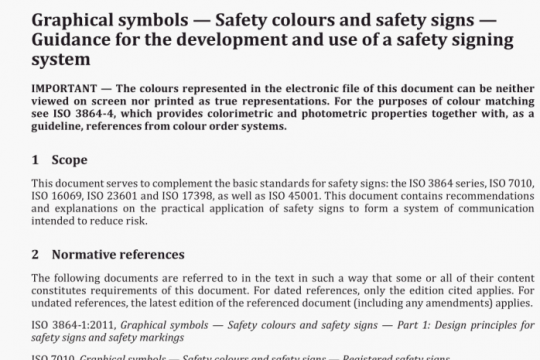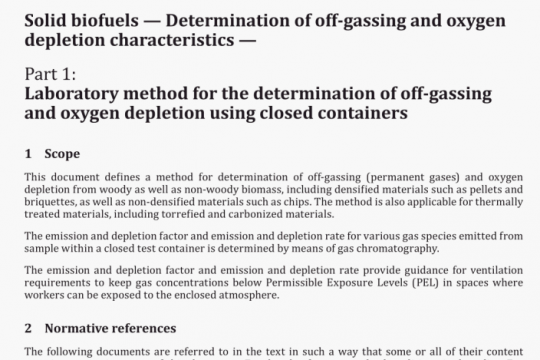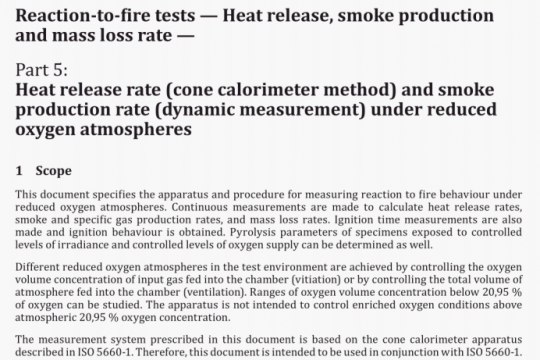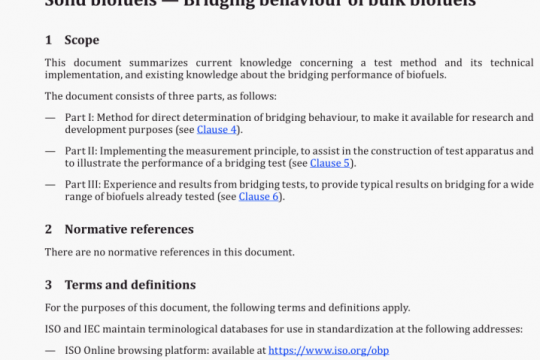ISO 24267 pdf free download
ISO 24267-2020 pdf free download.Footwear – Determination of coefficient of friction for footwear and sole components – Test method.
3 Terms and definitions
For the purposes of this document, the terms and definitions given in ISO 13287:2019 apply.
ISO and IEC maintain terminological databases for use in standardization at the following addresses:
— ISO Online browsing platform: available at https://www.iso.org/obp
— TEC Electropedia: available at http://www.clectropedia.org/
4 Principle
The footwear item and underfoot surface are brought into contact, subjected to a specified vertical force for a short period of static contact then moved horizontally relative to one another at a constant speed. The horizontal frictional force is measured at a given time after movement starts and the dynamic coefficient of friction is calculated for the particular conditions of the test.
S Apparatus and materials
Use apparatus and materials in ISO 13287:2019, Clause 4.
NOTE Regarding standard shoemaking last in ISO 13287:2019. 4.1.1, other lasts with the same dimensions of STM6O3LTM1) lasts can also be used.
Additional materials/accessories to test samples according to 1 to :
5.1 Cellulosic insole material of around 2 mm in thickness for testing soles which are going to be used in the footwear with an insole (for testing according to to ).
1) STM6O3LTM Is the trade name of a product supplied by SATR.A (https://www.satra.com/). This information is given for the convenience of users of this document and does not constitute an endorsement by ISO of the product named. Equivalent products may be used if they can be shown to lead to the same results.
5.2 Means to secure the soles to the last, as mechanical means, double sided adhesive tape, seal, adhesives, bands, etc. (for testing according to Z to ).
5.3 Saw and/or sanding machine, for sample preparation (for testing according to 8. and &4).
5.4 Mechanical systems to attach to the equipment spigot small-sized top-pieces, bigger top pieces, Slider 96TM2) test piece or other testing samples to the testing machine, that can be used to replace the shoemaking lasts or mechanical foots (for testing according to 8.5).
5.5 High-hardness rubber material of at least 50 mm x 50 mm (thickness of 2 mm), for small- sized top piece testing (for testing according to 8.5).
5.6 Metallic plate made of e.g. aluminium, of at least 180mm x 80mm and 2,5 mm thick, for sheet material testing (for testing according to 8k).
6 Sampling and conditioning
6.1 Sampling
Two samples shall be tested, right foot and left foot whenever possible, with the exception of top pieces where 2 test pieces shall be tested and sheet material where 2 test pieces shall be tested per direction.
6.2 Conditioning
The test items shall be conditioned prior to the test at 23°C ± 2°C and 50% ± 5% HR (Relative Humidity) for a minimum of 24 h. If necessary, the sample may be removed from this standard atmosphere, provided that its temperature is maintained at 23 °C ± 2 °C. that testing starts within 30 mm after removal from this standard atmosphere and that the testing is carried out at 23 °C ± 2 °C.
7 Preparation of sample and floor
All footwear test specimens shall be tested in the new condition so as to take account of the surface finish.
Use method described in ISO 13287:20 19, Clause 7, for preparation of samples and floor prior to testing.
Worn footwear may be tested in the condition in which they are received.
It is possible to evaluate the friction after simulating real wear by ageing the footwear. In this case, the ageing method shall be reported with CoF (Coefficient of Friction) results of aged sample.
Prior to testing, condition test specimens according to 2.
8 Test method
8.1 Test modes and test conditions for footwear with low heel seat height
Test modes and conditions shall be those of ISO 13287:2019, excepting for children footwear, size below 34, in which a vertical force of 250 N instead of 400 N will be used
Common contaminant conditions for daily footwear may be the following:
— Detergent solution according to ISO 13287:2019, 4.12.
2) Slider 96TM is the trade name of a product supplied by Smithers Rapra (https://wwwsmithers.com/home).
This information is given for the convenience of users of this document and does not constitute an cndorsement by
ISO of the product named. Equivalent products may be used if they can he shown to lead to the same results.ISO 24267 pdf download.




